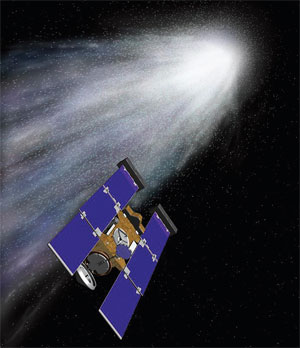Cosmochemists share results of cometary dust analysis
By Steve Koppesskoppes@uchicago.edu
News Office
 Photo courtesy of NASA Steve Simon and Lawrence Grossman of the Geophysical Sciences Department analyzed some of the first samples of a comet ever returned to Earth by a spacecraft. The artistís rendering above shows the Stardust spacecraft during its close encounter with comet Wild 2, during which the samples were collected. |
|
University cosmochemists Lawrence Grossman and Steven Simon have studied scores of meteorites during their careers, with a few Apollo lunar samples thrown in for good measure. But until 2006, they had never before examined a verified sample of a comet.
Much to their surprise, what they found looked a lot like components of some of the meteorites in their research collection.
“The thing that strikes me about the sample is how similar the mineral identities and the chemical compositions are to the things that we find in carbonaceous chondrites,” said Grossman, Professor in Geophysical Sciences and the College.
These meteorites contain material that has been unaltered since the birth of the solar system 4.5 billion years ago. The cometary grains differ from carbonaceous chondrites in their complete lack of water-bearing minerals, however.
The comet samples that Grossman and Simon examined were among thousands of dust particles that NASA’s Stardust spacecraft collected from Comet Wild 2 in January 2004. Two years later, Stardust became the first mission to return samples of a comet to Earth.
Stardust was scientifically important because comets are usually out of reach, Grossman said. And yet, aside from the sun, they may be the most abundant material in the solar system. “There may be more stuff in the comets than in all the planets put together,” he said.
Grossman and Simon were among the 75 co-authors who published the first analysis of the comet Wild 2 particles in the Dec. 15, 2006 issue of the journal Science. The Chicago scientists and 10 co-authors will present new Wild 2 data in the November 2008 issue (expected to be published early this year) of Meteoritics and Planetary Science.
The tiny cometary particles enabled Grossman, Simon and their colleagues to track the violent convulsions in the giant cloud of gas and dust that gave birth to the solar system. The convulsions flung primordial material billions of miles from the hot, inner regions of the gas cloud, which later collapsed to form the sun, out into the cold, nether regions of the solar system. There they became incorporated into an icy comet.
The team identified three particles described in the Meteoritics study as pieces of a shattered refractory inclusion, one of the most unusual and informative materials discovered in early analyses of the Wild 2 samples. Such inclusions, found in some meteorites, formed by condensation from the gaseous cloud that formed the sun at temperatures of more than 2,500 degrees Fahrenheit early in the history of the solar system.
“If you take a gas of solar composition and let it cool down, the very first minerals to solidify are calcium- and aluminum-rich,” said Simon, Senior Research Associate in Geophysical Sciences. Wild 2 contains these and other minerals formed at high temperatures.
“That’s an indication of transport from the inner solar system to the outer solar system, where comets are thought to have formed,” he said.
Either turbulence within the nebula, or a phenomenon called bipolar outflow from the early sun could account for the long-distance transport of cometary material, according to Simon and his Meteoritics co-authors.
Bipolar outflow results when the rotating disks that surround developing new stars jet gas from their polar regions, which astronomers have observed telescopically. “That’s part of the so-called X-wind model, which is somewhat controversial,” Simon said.
The controversial aspect of the X-wind model is the claim that the process would produce the kind of granules that Simon and his colleagues have now identified in comet Wild 2. Another less likely possibility: The cometary material in question may have formed around another star of composition similar to the sun, then drifted into the outer reaches of the solar system. There it became incorporated into comet Wild 2.
Scientists organized the Stardust mission expecting that Wild 2’s samples would reveal a bonanza of exotic minerals, including debris from ancient, distant stars that had met their demise long before the birth of the sun. They may now need to rethink how comets formed, Grossman said.
“Because they’re loaded with ices, we’ve always thought that these are outer solar system objects,” he said. “But maybe cometary ices formed much closer in, after the inner part of the solar nebula cooled off, and incorporated the high-temperature stuff that formed earlier.”
![[Chronicle]](/images/sidebar_header_oct06.gif)